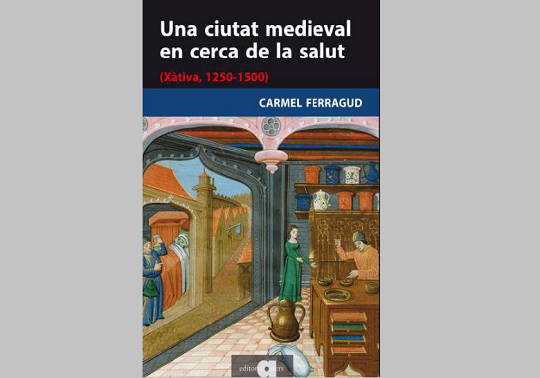
Presentation of the book Una ciutat medieval en cerca de la salut (Xàtiva, 1250-1500) by Carmel Ferragud.
Interventions: Carmel Ferragud (IILP-UV and author of the book), Mari Luz López Terrada (Ingenio, UPV-CSIC) and Vicent Olmos (editor and historian).
Editorial Afers has just published a new book by Carmel Ferragud, researcher at the Instituto Interuniversitario López Piñero, under the title Una ciutat medieval en cerca de la salut (Xàtiva, 1250-1500). If ten years ago La cura dels animals: menescals i menescalia a la València medieval appeared, right now the editor Vicent Olmos is once again relying on a monograph that focuses on subjects that a priori seem not very commercial, because the book that has just been published deals with another aspect of Valencian medicine in medieval times. Xàtiva City Council is co-edited the book, demonstrating that the land of Lluís Alcanyís has been sensitive to a subject that is not usually among the most outstanding in the historiographic panorama.
Studies dedicated to the practice of medicine in the municipalities of the Crown of Aragon during the Late Middle Ages from the perspective and methodology of local history have hardly proliferated. Since Luis García Ballester's classic work on the city of Valencia (La medicina en la Valencia medieval, Valencia 1988), no specific monographs have been produced on this subject. However, it is necessary to highlight some works made from other perspectives (such as the famous Medicine before the plague by the North American historian Michael McVaugh, Cambridge 1993), which have gone into the study of medicine practiced in the municipal sphere, although linking data from numerous towns and cities, and not making an exhaustive approximation that has only one place as an analysis laboratory. This absence comes as surprising because the amount of documentation preserved in the municipal archives of the territories that built the former Crown of Aragon is truly extraordinary for studying the subject, both for the quantity and the quality of its content. In this sense, it may seem anomalous that it was precisely the city of Xàtiva, which lost most of its written memory as a result of the urbanicide suffered during the War of Spanish Succession (1707), the chosen one to analyse how a group of people was organised to handle everything related to hygiene, health maintenance, illness prevention, the organisation and control of medical care and the use of medical professionals to contribute to good management and improve the quality of life of the city. But sometimes these challenges are what spur research.
Carmel Ferragud has reconstructed this entire medical scene for Xàtiva’s city out of materials that have been preserved in several historical archives. The second city of the Valencian kingdom had to forcefully leave an important documentary base beyond the limits of the municipality, and this was what has allowed to rescue enough data to offer a comprehensive picture. Paradoxically, it is the limited number of preserved sources that has allowed such an exhaustive study of the subject, without having to discard many related aspects. In fact, when one wants to study this subject in cities such as Valencia, Barcelona or other large late-medieval urban centres, the avalanche of information that appears is of such magnitude that one must necessarily choose to deal with more specific subjects or focus attention on a much shorter chronological period. Even so, this makes you lose sight of a general overview and a wide chronological range such as the one that Ferragud's book has been able to offer. An approach that tries to explain the situation that practitioners of Galenic medicine had to deal with against the medical needs of a society that was Christian from its very foundational moment, despite the coexistence with Muslims and Jews.
The title of the book includes a tribute to Luis García Ballester, a key figure in the beginning of medicine’s history from contextual presuppositions in the Valencian (and not only Valencian) realm, and more specifically to his posthumous work, La búsqueda de la salud: sanadores y enfermos en la España medieval (Barcelona 2001).
Date 3 october 2019 at 18:00 to 19:00. Thursday.
Sala de Conferencias, Palau de Cerveró, Plaza Cisneros, 4. 46003 Valencia.
IILP.
Contact mrile@uv.es









